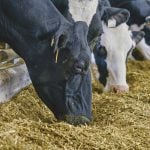Most of Western Canada experienced harsh winter conditions earlier in December, causing many auction barns to post pone sales by one or two weeks. Cattle buyers have now found larger volumes of lighter-weight calves coming on the market, which tempered the upside in the feeder cattle complex.
Western Canadian calves were a solid $3 to $6 per hundredweight (cwt) higher on average, with year-end buying stepping forward more aggressively. Larger operations were looking to place lighter calves in backgrounding operations or fill up a couple of empty pens, now that margins look more profitable. Barley and feed wheat values continue to grind lower and there is a fair amount of grain stored on the ground.
Read Also

U.S. livestock: Cattle futures sink on concerns over Trump’s push to lower prices
Chicago | Reuters – U.S. cattle futures tumbled on Monday, extending a steep slide after President Donald Trump complained last…
Over the past month, new faces have shown up at auction markets that have not been around for the past two years. It appears that lower grain prices have encouraged the farmer cattle producer to fill two or three pens in a custom lot. U.S. feeder cattle prices were $4 to $8/cwt higher on average, especially on lighter calves, and this strength led the Canadian market higher. U.S. orders were the main feature driving the market in Manitoba and eastern Saskatchewan.
Feather-light calves under 400 pounds were trading in the range of $185 to $200 this week, up about $10/cwt on average from seven days earlier. Black Angus-based steers weighing just under 500 pounds with full documents sold for $185/cwt in southern Alberta. This was about $8 to $10/cwt higher than cattle of similar weight, but reflects that buyers were willing to pay up for quality. Weather discounts that were noted earlier in December have now evaporated because these calves can withstand the adverse conditions. A mixed group of heifers with no special feature weighing 870 lbs. sold for $130 in central Alberta. An small group of larger-frame medium-flesh exotic steers weighing 825 lbs. sold for $145 in the same region.
Feed grain values have potential to drop $20 per tonne because the commercial elevator system is plugged for the next four to six months and farmers will be anxious to move grain after the holidays. Feedlots have experienced positive pen closeouts for about three months and there appears to be a higher risk propensity. Given this environment, feeder cattle prices are expected to stay firm through January.
— Jerry Klassen is a commodity market analyst in Winnipeg and maintains an interest in the family feedlot in southern Alberta. He writes an in-depth biweekly commentary, Canadian Feedlot and Cattle Market Analysis, for feedlot operators in Canada. He can be reached by email at [email protected] for questions or comments.
















